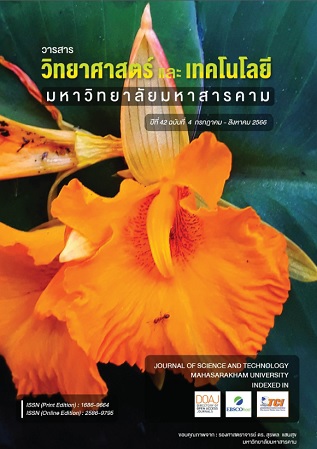Development of a Biodegradable Film from Thai Jasmine Rice Flour
Main Article Content
Abstract
This research aimed to study the forming process impacting film properties. The film formation was based on Thai jasmine rice flour with using glycerin as a plasticizer in amount of 3, 6, and 9 grams respectively. The compare of heat pump drying machine to hot air drying machine with 35 degree Celsius was made in drying process. Mechanic properties: Tensile strength and elongation; physical properties: color, solubility, water vapor permeability, and application for biscuit packaging; and percentage of degradability were examined. The result showed that the decrease of tensile strength correlated to increase amount of glycerin. Also, The color were L*=78.25, a*=1.5 and b*=7.0 sequentially. The elongation, solubility and water vapor permeability rate increased when the amount of glycerin rose. The moisture content of the film was between 8.68 and 10.59%db. The study also found that when it was used for biscuit packaging, the film with high glycerin affected the moisture of biscuit. That is, the moisture of biscuit was high; but its crispiness was low. For dying process, when comparing hot air drying machine to heat pump drier, the finding reported that heat pump drying machine was able to better delay water vapor permeability into biscuit. Biodegradable film from Thai jasmine rice flour with high glycerin degraded in less time. It can be applied to bio-based packaging production in order to substitute the synthetic, which can reduce indecomposable waste in the future.
Article Details
References
กมลทิพย์ เอกธรรมสุทธิ์. (2553). ผลของซีนไฮโดรไลเซทต่อสมบัติทางกายภาพของฟิล์มแป้งบุก. วารสารวิชาการมหาวิทยาลัยหอการค้าไทย, 30(1), 81-89.
กมลทิพย์ เอกธรรมสุทธิ์ และอดิศักดิ์ เอกโสวรรณ. (2543). ฟิล์มแป้งบุกชนิดบริโภคได้: การเตรียมสมบัติบางประการ และการนำไปใช้ประโยชน์. อาหาร, 30(1),
-51.
ชาลีดา บรมพิชัยชาติกุล. (2555). เทคโนโลยีการทำ แห้งแบบผสมผสาน: การนำมาใช้เพื่อถนอมผลิตภัณฑ์อาหารที่ไวต่อความร้อน. วารสารวิจัยและพัฒนา มจธ, 35(2),269-283.
ภาวิณี เทียมดี และกวินนา สุขสำ ราญ. (2563). การพัฒนาฟิล์มย่อยสลายได้จากแป้งมันแกวเพื่อประยุกต์ใช้เป็นถุงเพาะชำ . วารสารวิชาการและวิจัย มทร.พระนคร, 14(1),1-14.
รังสินี โสธรวิทย์. (2560). ฟิล์มและสารเครือบพอลิเมอร์ชีวภาพสำหรับระบบอาหาร. (พิมพ์ครั้งที่ 3). สำนักพิมพ์มหาวิทยาลัยเกษตรศาสตร์
โสภิดา วิศาลศักดิ์กุล, อรวัลภ์ อุปถัมภานนท์, กุลวดี สังข์สนิท,สุภา จุฬคุปต์ และสุทัศนีย์ บุญโญภาส. (2559). การพัฒนาผลิตภัณฑ์พลาสติกชีวภาพจากแป้งเมล็ดขนุน. วารสารวิทยาศาสตร์บูรพา, 21(2), 216-228.
สำนักมาตรฐานสินค้าส่งออก กรมการค้าต่างประเทศ (2564, 20มิถุนายน). สถานการณ์ข้าว. https://www.dft.go.th/th-th/
หมอเกษตรทองกวาว (2562, 12 มิถุนายน). อัตราการแปรรูป “ข้าวเปลือก” เป็น “ข้าวสาร” ของไทยสีได้กี่เปอร์เซ็นต์.เทคโนโลยีชาวบ้าน. https://www.technologychaoban.com/
อัจจิมา อุ่นแก้ว, เจนจิรา รอดสุโข, พรนภา เกษมศิริ และวลัยพร เหมโส. (2563). การศึกษาคุณลักษณะของฟิล์มบรรจุภัณฑ์ย่อยสลายได้จากข้าวไรซ์เบอรี่. วารสารวิจัย มข. (ฉบับบัณฑิตศึกษา), 20(4), 81-93
Asgar, F., Bahareh, S. and Mahsa, M. (2013). Effect of Glycerol on Physical and Mechanical Properties of Wheat Starch Edible Films. Journal of Texture Studies, 44(3), 176-186.
ASTM D882-02. (1995). Standard Test Method for Tensile Properties of Thin Plastic Sheeting. https://www.astm.org/d0882-18.html
Dang, M.N., Thi, V.V.D., Anne, C., Grillet, H.H.T. and Chi, N.H.T. (2016). Biodegradability of polymer film based on low density polyethylene and cassava starch. International Biodeterioration & Biodegradation, 115, 257–265.
Margarita, M.A.M., Delia, R.T.B. and Florencia, C.M. (2012). Development and optimization of biodegradable films based on achira flour.
Carbohydrate Polymers, 88(2), 449–458.
Mohammad, J., Naimeh, K., Mehran, G. and Mehri, H.N. (2013). Effect of glycerol concentration on edible film production from cress seed carbohydrate gum. Carbohydrate Polymers, 96(1), 39-46.
Mohammad, J., Farideh, T.Y., Seyed, A. M. and Arash, K. (2013). Physical, barrier and antioxidant properties of a novel plasticized edible film from quince seed mucilage. International Journal of Biological Macromolecules, 62, 500–507.
Pawinee, T. and Thanyalak, A. (2019). The effect of glycerol content on physical and mechanical properties of the biodegradable film from sweet potato flour for preserving namwa banana. Life Sciences and Environment Journal, 20(1), 70-80.
Sothornvit, R. and Krochta, JM. (2000). Water Vapor Permeability and Solubility of films from Hydrolyzed Whey Protein. Journal of Food Science, 65(4), 700–703.
Tapia-Blácido, D.R., Amaral, S.P.J.d, and Menegalli, F.C. (2013). Effect of drying conditions and plasticizer type on some physical and mechanical properties of amaranth flour films. LWT - Food Science and Technology, 50(2), 392-400.


